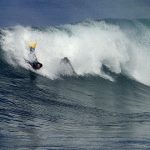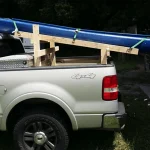Setting up the kite
Positioning
You should try to set your kite up as close to the launch area as possible, so you won’t have to carry it across the beach after you’re done setting it up.
Make sure there are no obstacles in the path of the kite’s wind.
Given the wind direction, you should always stand with your back to the wind when setting up your kite.
Somewhere near the center of the leading edge, there is a loop that the pump leash can be attached to, near the inflation valve.
It’s a good idea to pump a few times before attaching the pump nozzle to the valve. This clears out any sand that might have gotten inside the tube and keeps sand from getting inside the kite bladder.
The struts need to be pumped up first.
Start with the kite only unrolled enough to reveal the inflation valve if you only have a one-pump system.
Now you stand with both feet on the kiteboard, inflate the kite a little so it opens out, and hold onto the bar.
Make sure the bridle lines are all resting on the bottom side of the kite and not looped around it.
Now you can pump up the kite fully.
Ensure that the kite is inflated to its fullest. It can be tough to over-inflate the kite, but it is possible if you are using a pump with a high capacity.
Check for creases in the struts and leading edge. If the leading edge is properly inflated, it will make a drumming sound when flicked.
If your pump has a pressure gauge, check the required pressure, which is usually on a label on the leading edge. If it doesn’t have a pressure gauge, check the manual.
The type of valve your kite has will depend on the brand, so it’s a good idea to check how yours works before taking off. Be sure to close and secure the valve properly. If the kite hits the water or sand forcefully, the valve closure could pop out or leak if it’s not properly closed and secured.
You should have your kite inflated and arching up at the tips. You should be able to hold it by one point with your back to the wind.
Now is a good time to check the kite for any damage. If there is any, don’t go out!
Detach the pump leash while still holding onto the kite.
head toward one of the kite’s wingtips and rotate the kite so the leading edge is into the wind. Then place the kite on the ground, leading edge down.
If the device is positioned correctly, the center support will be pointing in the same direction as the wind.
You should always throw a few handfuls of sand onto the leading edge of the canopy to prevent the kite from being picked up by any sudden gusts.
Setting up your kite lines
This is because the wind will be blowing the kite into the lines, which makes it much easier to keep the kite under control. The lines can be set upwind or downwind of the kite, but it is easier to keep the kite under control when the lines are downwind.
There are two reasons for putting the kite upwind of you when you launch. Firstly, you have a good view of the bridles and easy access to the pig-tails you’ll be attaching the lines to.
Secondly, with the kite upwind of you when you launch it won’t suddenly power up.
Unrolling the lines
Unrolling a meter or so of the lines, I place them on the ground under the upturned kite and weigh them down with a handful of sand to stop them from getting blown around.
Now, walking backwards carefully unroll the lines fully.
Bar orientation
Most kite brands have a coloring system where one end of the bar is a bright color like red, and the other end is a neutral or blue color.
The kite’s tail is red and it is left behind when the kite is in the air.
The kite is upside down, so the bar needs to be placed with the red end on the right.
The pigtails on the kite should be colored the same as the correct end of the bar for that side.
Untangling and checking the lines
This is the most important stage of the setup.
Step between the outside lines with the center line and power lines between your legs, with your back to the bar.
With your fingers holding both a power line and a steering line, walk slowly towards the kite. As you walk, let the lines run through your fingers so that they gradually become separate.
You can either leave the power lines on the ground, or do the steering lines first. If you do the steering lines first, you can then go back and repeat the process with the power lines.
You should not go kitesurfing if the lines are kinked, knotted, frayed, or abraded. Ask an experienced kitesurfer for advice and consider replacing the lines.
Taking a chance may be tempting, but a snapped line can be extremely dangerous. The kite could go into a powered-up “death loop” if you’re not careful. Trust me, you don’t want that to happen.
The text is saying that at the end of the stage, the lines should be near the attachment points of the kite.
Attaching the lines
Heads up! First, check that the bridles are not tangled or twisted, and that the pulleys are in good condition and free from any debris.
The end of the kite lines on some kite brands will have a loop, and the corresponding attachment point will have a knot or series of knots. Other kite brands will have a “pig-tail” attachment on the kite with a loop.
To make a larks-head noose, take the section of the line below the loop and push it through the loop to form a noose. Feed the knotted end through the noose and pull the line to tighten.
If you have more than one knot in your string, you can use it to adjust the length of the string and change the kite’s tuning. For now, use the second knot, which is probably about 5 cm from the end.
If so, quickly rinse it and you’re done! Make sure to check the bar end before you go. Pick up the bar and make sure the lines aren’t crossed over or stuck on any debris from the beach. If they are, rinse it off quickly and you’re all set!
Kit Set Up
Sweet as Nuts
You want to keep the kite trimmed while flying so that it’s flying at the best angle to the different forces around it. This is when there is equally strong tension on the front and back lines.
If the kite is flown this way, it will move you forward, go upwind, turn when you want it to, and generally behave the way it’s supposed to, making your time flying it enjoyable.
The best way to feel when your kite is perfectly trimmed is to pull the bar in until you are sure the back lines have gone tight, and then gently letting it out until you feel the kite pulling less and less on your arms.
The sweet spot is the position of the bar the moment just before the back lines slacken.
Everything is good in theory, but when you’re focused on the busy world around you, it’s easy to hold onto the bar in any way you can without thinking about what it’s doing to the kite in front of you.
The sweet spot can be affected by things like gusts of wind, lulls, your speed, and even the state of the water, so you need to be constantly aware of it.
We got De-power
If the back lines are not under enough tension, or if there is no tension on them, the kite will not fly properly. It will feel sluggish and unresponsive to steering, because the back lines are not pulling on the kite.
de-powering the kite means that you are no longer using all of the kite’s power. This is useful for regaining control, slowing down, stopping, or when you wipe out.
Flaring
Flaring happens when there is too much tension on the back lines, which can cause the kite to fly or fall backwards.
This is dangerous because it can encourage the kite to fly/fall backwards. If you pull the bar past the sweet spot, you will flare the kite, which often leads to the kite falling back into the power zone.
A classic launching nightmare occurs when there is not enough power to hold the shape of the kite, whether from the water or land. If you see your kite flying backwards, push the bar back towards and past the sweet spot to allow the kite to fly forwards again.
If the wind is stronger, you can still get the kite to flare by muscling the bar past the sweet spot, but instead of falling back, it will fly further back in the window and downwind of you.
This makes it hard to jump because it pulls you off your edge too early, and makes it feel like you’re overpowered, even though you’re not.
One of the most misunderstood aspects of kiting is the idea that “pulling the bar in creates more power.” You should only pull the bar in as far as the sweet spot.
The truth is that your kite is only as powerful as it is, and if there is not enough wind, the only way to create some extra power is to work your kite around the window. You cannot make more power just by pulling the bar; you’ll kill the power.
The Sweet Spot
Once you get moving at speed, the sweet spot on your bar will move further away from you than it was when you were standing on the beach due to the added power created by the kite moving.
Pigtails
Some manufacturers provide many options for both front and back attachment points. The best way to figure out which configurations work best is to experiment. If possible, use the same attachment point on the front lines, and only change the back attachment points if necessary.
If you attach the back lines of your kite to the attachment point at the end, furthest from the kite, you are effectively lengthening them. If you attach them to the attachment point nearest the kite, you are shortening them.
Try and find a balance with the front and back attachments so that when you have power in the kite, your bar’s sweet spot is just lower than the middle of your chicken loop line.
We only ever use the bottom and middle settings. These two settings enable us to find the right setting depending on the wind strength and kite size. If it’s a marginal wind, we opt for the middle setting. If we have sufficient power, we opt for the bottom setting.
Meanwhile Back at the Bar
This bar has all the controls in one place. You can attach the lines to the kite however you want, and the bar’s sweet spot will be lower than halfway down the chicken loop line.
You can use the center line adjustment strap to trim the bar to where the sweet spot is.
The Strap
There are many different names for the line that adjusts the center of the kite, so to avoid arguments, we will call it the strap. The strap is actually used to adjust the position of the bar.
Some kiters believe that if they pull down on the strap, it will take power away from the kite. However, this is not the case. The size of the kite is what determines its power.
The strap controls the position of the bar, and thus the sweet spot. So, if you feel there is too much power, you can lower the bar by pulling on the strap. This will create more space above the sweet spot, allowing you to reduce the power of the kite by sheeting out.
However, if you start with the kite set up so that the bar is close to the chicken loop without pulling on the strap at all, then pulling on the strap will have no effect as the back lines will be slack.



